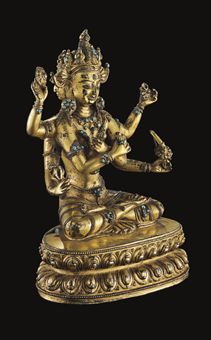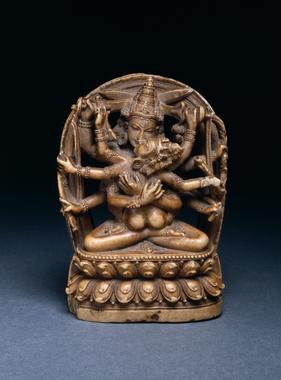
Circa 1360, Tibet, Densatil, Amitabha aspect of the Guhyasamaja retinue, gilt copper alloy, photo after Huang Chunhe from an article on Densatil by Jean-Luc Estournel, at the Capital Museum in Beijing (China).
This princely figure with three heads, each with three eyes, and six arms (see close up on the above link) holds a lotus and a sword in his upper hands, the stem of a lotus supporting a dharma wheel and a vajra bell in his main hands, a lotus supporting an object difficult to identify in his middle left hand, the sixth attribute is broken.

Circa 1407-1408, Tibet, Densatil, Amitabha aspect of the Guhyasamaja retinue, gilt copper alloy, photo as above, Fig. 245, at the Capital Museum in Beijing (China).
In his middle right hand this one holds a lotus topped with a small vajra sceptre and in the left one he has a lotus topped with a triple gem (triratna).

Circa 1386, Tibet, Densatil, Ratnasambhava from the Guhyasamaja retinue possibly, gilt copper alloy, photo Michael Henss from the same article, Fig. 182.
Also with three heads (but no third eye) and six arms, this character holds his attributes directly in his hands: a dharma wheel, a vajra sceptre, a sword, a vajra bell, the lower right hand is cupped as if to hold an object such as a visvajra, a triple gem or a vase, the middle right hand holds the stem of a broken lotus or the handle of a broken implement.
The following were published with sculptures of Akshobhyavajra Guhyasamaja. In the light of Jean-Luc Estournel’s work the information needs updating and, since they are definitely retinue figures, they have been moved to this post.

14th century, Tibet, six-armed yidam, possibly Akshobhyavajra or a retinue figure, gilt copper alloy, private collection, photo on Sotheby’sUpdate: Circa 1434, Densatil, Vairocana from the Guhyasamaja retinue, Fig.332 in the aforesaid article.
Unlike Akshobhyavajra, this three-headed figure is alone. He holds a wheel and a bell in the main hands, a lotus and a vajra sceptre in the remaining right hands, a sword and a flaming jewel in the other left hands. He is seated on a single lotus atop a cut-out throne supported by two lions and decorated with a vase containing scrolling lotuses.

16th century, Tibet, Guhyasamaja retinue figure? (labelled ‘Amoghasiddhi’), gilt copper alloy and stone inlay, private collection, photo by Nagel, 2015.
Update: Circa 1434, Densatil, deity from the Guhyasamaja retinue, Fig. 331 from the aforesaid article.
A similar character, holding a sword and a bell in the main hands, a wheel and a flaming jewel in the upper hands, a vajra sceptre and a lotus flower in the lower hands. seated on a single lotus over a throne decorated with studded leaves, an embossed visvajra (associated with Amoghasiddhi and a few more deities), foliage and thick beading, the plinth finely incised with a floral motif.
This single figure also has the effigy of a buddha behind his crown.

14th century, Tibet, Ratnasambhava, gilt copper with gems and painted details, private collection, photo on Sotheby’s Update: circa 1360, Densatil, probable aspect of Ratnasambhava, Fig. 84 in the aforesaid article.
A Nepalese-style three-head and six-arm deity holding a triple gem and a bell in his main hands, a sword and broken implements in the others. The lower part of the lotus throne is decorated with visvajras surrounded with foliage, and upright vajras in between. Sotheby’s tell us that he has a tiny effigy of Akshobhya behind the central panel of his crown. We have seen several Akshobhyavajra Guhyasamaja retinue figures with a similar iconography but none with a triratna in one of the main hands. Although wisdom buddhas don’t normally have more than two hands Sotheby’s suggest that this is a form of Ratnasambhava seen in the thirty-two deity Guhyasamaja mandala.
16th-17th century, Tibet, Jnanadakini, gilt copper, private collection, photo on Koller Update: circa 1431-1432, Densatil, bodhisattva from the Guhyasamaja retinue, Fig. 286 in the same article.
14th century, Tibet, Guhyasamaja retinue figure, gilt copper alloy, photo on Christie’s
This rare sculpture depicts a retinue figure with the same attributes as Akshobhyavajra: a vajra sceptre and a bell in his main hands, a wheel and a lotus in the upper ones, a faceted jewel and a sword in the lower ones.










